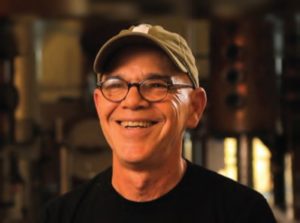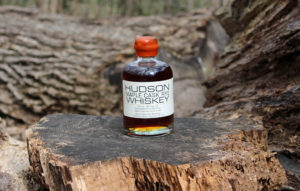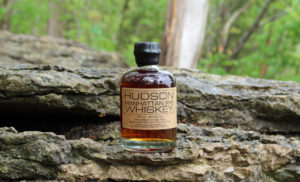The Founder of Tuthilltown And Hudson Looks Back As A Distiller And Talks About The Sale To William Grant & Sons
By Richard Thomas
When I first reached out to Ralph Erenzo, founder of Tuthilltown Distillery and Hudson Whiskey, it was with an eye the recently passed 10th anniversary of the founding of his distillery. One of the forerunners of the craft distilling movement, Erenzo started Tuthilltown in 2006, when his plans to run a climber’s hostel didn’t pan out due to a virulent local strain of NIMBYism. Erenzo was the first to put to use a 2000 New York state law that slashed licensing fees for small distilleries.
Erenzo sold the brand Hudson Whiskey to William Grant & Sons, owners of Glenfiddich and Tullamore Dew, in 2010, but retained ownership of the distillery itself. A week ago, he finally sold the distillery to the Scotch company as well. So, what was intended to be a retrospective on the early days of craft distilling became instead also about the ongoing wave of American craft whiskey acquisitions.
RT: So, I understand Tuthilltown started out as a rock climbing destination, and when that didn’t work out you turned to distilling because of a serendiptious change in New York state law at the time that made it easier to start a small distillery. But you’re an avid climber. Have your thoughts ever returned to that idea of creating a hostel for climbers or something like that?
RE: I originally set out to open a rock-climbers ranch but my neighbors at the time weren’t overly enthusiastic about that prospect and didn’t make it very easy to actually move forward with which required me to sell of a few pieces of land. We since purchased them back; and needed to find a new way to make a living with this property. Someone suggested opening a winery, but I knew I didn’t want that. Through research I found out that there had been distilleries in New York in the past, but hadn’t been any since Prohibition because the permit fee was $65,000 before you even make a drop of liquid. Then I found that a year earlier the fee was dropped to $1,500 for three years. That I could do. So I started distilling without any prior knowledge, getting instructions off the internet.
While developing the Tuthilltown Spirits Distillery, I continued to advocate for a climber campground near the Mohonk Preserve. It took a few years to get all the players assembled but the Mohonk Preserve, the State of New York and the American Alpine Club have created a climber campground with all the amenities. So, problem solved.
RT: What prompted you to sell the distillery itself now, almost seven years after selling the Hudson brand?
RE: We’ve been working with William Grant & Sons for a number of years and look forward to building on that relationship to help Tuthilltown fully achieve its potential. The deal had been in the works since the beginning of the relationship. Brian and I wanted to put Tuthilltown into the hands of owners we trust and what better organization is there to do to that than William Grant & Sons.
RT: Where does that name Tuthilltown come from anyway? I know it’s the name of the old mill, but where did the mill get it from? And why is the distillery Tuthilltown, but the whiskey is called Hudson?
RE: Tuthilltown Gristmill, a landmark listed on the National Register of Historic Places, used waterpower to make flour from local grain for 220 years.
The builder of the mill was Selah Tuthill. He was 18 years old. That was in 1788. The neighborhood became known as Tuthilltown and was the actual center of what is now the Town of Gardiner until the railroad came through when the Town Hall and Post Office were moved to Gardiner Village. The original Town Hall and Post Office buildings still stand as private homes next door to the distillery.
RT: You were a trailblazer in 2006, one of the earliest whiskey-making micro-distilleries in America. More than a decade later, micro-distilling has made New York State a contender for becoming America’s No. 3 whiskey state, after Kentucky and Tennessee.
When you were getting started, did you have any idea it would get this big, this fast?
RE: We started out as the little-distillery-that-could. I had no idea I’d be making whiskey let alone this much whiskey. I set out to start a climbers’ ranch. My business partner Brian Lee and I began Tuthilltown Spirits in 2003. Our first whiskey expression, Hudson Baby Bourbon, was released in 2006, which is the first-ever New York State-produced bourbon. Hudson Whiskey is the first legal pot-distilled whiskey made in New York State since Prohibition and 90 percent of the grains we use are sourced from within 90 miles of the distillery. We produce handcrafted, artisanal spirits, one small batch at a time. And we hand-wax and hand-number each bottle. I wasn’t able to launch my Bunks in the Gunks climbing ranch, but ended up with a wonderful distillery and award-winning whiskey.
RT: I recall reading a while back you were lobbying to reduce Federal taxes on small distillers. In your view, what does craft distilling need in terms of regulatory and tax reform?
RE: The effort still is to gain parity with small brewers and wineries which already pay roughly 20% of the Excise Tax rate the large producers pay. Small craft distilleries pay 100% of the Federal Excise tax rate paid by the industrial producers, $13.50 per proof gallon. Maurice Hinchey (D-NY) introduced HR777 at my urging in 2006 which has evolved to be S.1562, introduced by Senator Ron Wyman (D-WY), The Craft Beverage Modernization And Tax Reform Act. It is well supported across both parties and the industry. That lobbying effort was by members of the American Craft Spirits Association Legislative Committee which I formed and chaired until last year. The effort is ongoing.
RT: With well over a thousand operational craft distilleries in America today, many observers are predicting a crash coming on, and at least some of the newcomers aren’t going to survive. Coming at it from your veteran’s perspective, what indicators would you look for in a micro-distillery that they will be able to ride out a big bump in the industry?
RE: Determined, hard working management and ownership. The distilleries who focus on establishing their regional base before overextending their distribution quickly will have a better chance. Expanding a little behind demand is a good practice. And beware of anyone offering you advice that will “make you a million dollars.” Protect the integrity of your business and the authenticity of their history and story. Deliver on your promises. Take care of your employees.
 The Whiskey Reviewer A World of Whiskey, Poured Every Weekday
The Whiskey Reviewer A World of Whiskey, Poured Every Weekday



